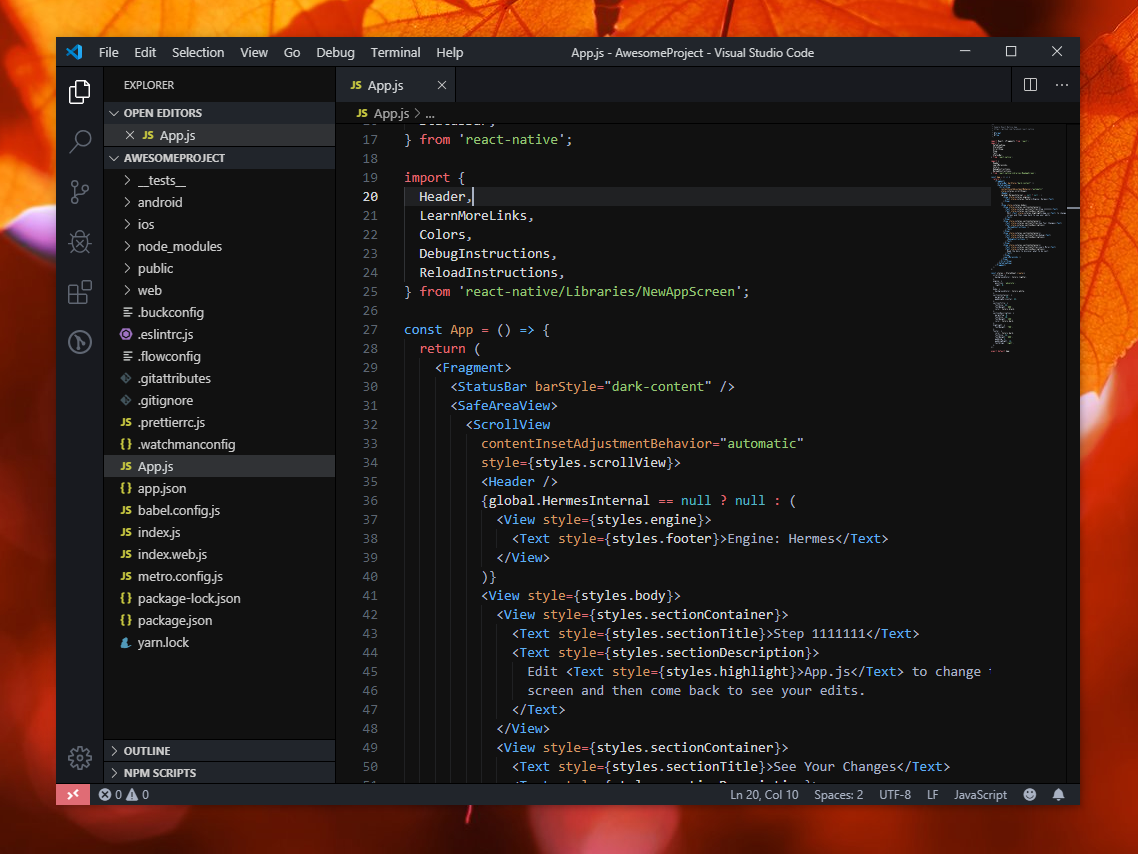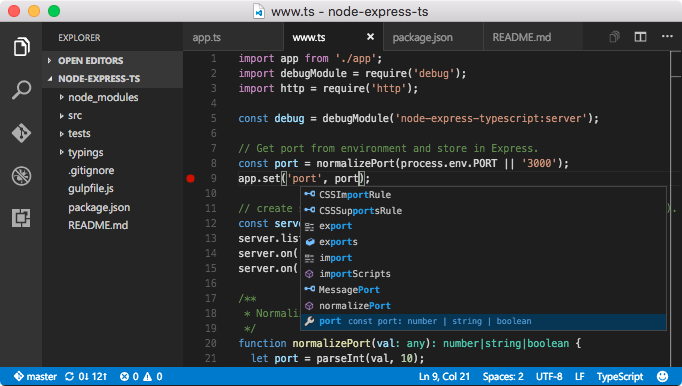Visual Studio Code For Ios
In this video, I'll show you the steps to build your first iOS application in Visual Studio 2019 with C#,.NET, and Xamarin. We will see how to build a basic. Cisco IOS Syntax Highlighting for Visual Studio Code. Install the extension with VSCode. Save a file with the.ios extension and open with VSCode. Visual Studio Marketplace. Drivers sequans others. Visual Studio uses Xcode for building process. Publishing to App Store Connect directly from Visual Studio is not possible for now. If I want to connect real device(to visual studio as targeted device) to create IPA file do I need to connect it in Mac or PC(Via USB cable) in order to get in VS PC. You need to connect your device to Mac.
- Visual Studio Ios Emulator
- Visual Studio Code Iostream Not Found
- Vs Code For Ios
- Visual Studio Code Ios Emulator
Visual Studio Code (VSCode) is a cross-platform text and source code editor from Microsoft. It’s one of the most exciting open source projects today, with regular updates from hundreds of contributors. VSCode was among the first tools to support Language Server Protocol (LSP), which has played a large part in providing a great developer experience, in a variety of languages and technologies.
With the previously announcednow shipping in Xcode, it’s a great time to see how this integration works for yourself.
This week, we’ll walk through the process of how to get started with Swift’s new Language Server Protocol support in Visual Studio Code on macOS. If you haven’t tried writing Swift outside Xcode, or are already a VSCode user and new to the language entirely, this article will tell you everything you need to know.
Step 0: Install Xcode
If you don’t already have Xcode installed on your machine, open the Terminal app and run the following command:
Running this command presents a system prompt.
Click the “Get Xcode” button and continue installation on the App Store.
You can verify that everything is working as expected by running the sourcekit-lsp command:
This command launches a new language server process, but don’t worry if it doesn’t provide any feedback to STDOUT — that means it’s working as intended. Exit the process with an ETX signal (^C).
Step 1: Install Visual Studio Code
Download Visual Studio Code and install it to your system Applications folder. Open the app and follow the instructions for launching from the command line. You’ll need to have the code command accessible from $PATH in order to install the SourceKit-LSP extension later on.
Electron apps have a reputation for being big and slow, but don’t let that stop you from giving VSCode a try — its performance and memory footprint are comparable to a native app.
Step 2: Install Node and NPM
VSCode extensions are written in JavaScript / TypeScript. If you’re not already set up for JS development, you can download Node (a JavaScript run-time for outside the browser)
and npm (a package manager for Node) with Homebrew using the following commands or manually by following these instructions:
To verify that you have a working installation, run the following command:
Step 3: Build and Install SourceKit-LSP Extension for Visual Studio Code
From the command line, clone the sourcekit-lsp repository and navigate to Editors/vscode in the resulting directory. Use npm to build the extension and then use the code command to install it:
Portrait displays others driver download for windows 10. Now launch (or relaunch) VSCode and open a Swift project, such as this one, and test out Language Server Protocol support for Swift.
To get the full experience of working with Swift from VSCode, we recommend that you also check out the Swift Lint extension (for real-time style and convention diagnostics).

So there you have it — the makings of a first-class Swift development experience outside of Xcode.
Visual Studio Ios Emulator
And with GitHub’s recent announcement of Codespaces, that future may be coming sooner than we once thought. Thanks to Swift’s support for Language Server Protocol, we’ll soon be able to edit Swift code — syntax highlighting, autocompletion, and all — directly from the browser.

Xamarin Remote iOS Simulator is a wonderful tool to be able to develop iOS solely on your windows desktop with Visual Studio and just have a network access to a Mac system.
While it was available for any Xamarin edition (even Community) during the preview, the simulator is now in a release state and available only for people with Enterprise licence which means nearly no one except people working in Fortune 500 companies.
But, since it works very well for the preview, why couldn’t we use it now ? The only reason: money ! That’s a pretty good reason for Xamarin/Microsoft but not for me.
Below you will find a method to be able to remove this limitation. This has only been tested on VS Pro but should work on VS Community too.
If you only want to be able to use it and not to understand the How, just go to the section Install modified version
Lets change this behavior
While the Remote iOS Simulator was in preview, it was available in the options as a checkbox in the iOS settings. Once Xamarin extension has been updated, this checkbox is only available for VS Enterprise edition. We need to get this checkbox back !
Xamarin is installed as an extension so all of its features are in the code in the extension. The extension is installed in C:Program Files (x86)Microsoft Visual Studio 14.0Common7IDEExtensionsXamarinXamarin, you could have multiple version available, pick the last one, previous ones are remainings of update process. In the extension directory, you can find many dlls
First we need to find the one which is controlling iOS deploy and settings. After some digging around, I found it’s Xamarin.VisualStudio.IOS.dll (kind of obvious no ?). Thanks to the wonderful dotPeek tool, I found two classes which check the Visual Studio edition :
- The ReadSettings method in MonoTouchSettingsDialog (in namespace Xamarin.VisualStudio.IOS.Dialogs). This method show or hide the checkbox in the iOS settings.
- The ResolveSimulatorLauncher method in MonoTouchDevice (in namespace Xamarin.VisualStudio.IOS). This method choose between iOS Remote Simulator and the Simulator on Mac when you want to launch your app on a Simulator
Visual Studio Code Iostream Not Found

Both of those method check if the current edition of VS is equal to 3, this is the value of an enum (Undefined = 0, Community = 1, Pro = 2, Enterprise = 3). Since the value is always less than 3, we gonna edit the dll to change the comparison to currentEdition < 7. Why 7 ? Because it’s a cool number greater than 3 and it’s available as a one byte IL instruction just like 3 (instruction ldc.i4.3 )
Now the difficulty is the dll is stronly named and so cannot be decompiled, modified and recompiled, VS will not load it in this case. Evernote inbox email. But our solution will be to edit the dll directly in hex format. For this, we need to have an hex editor (I choose HxD) and be able to find the correct bytes to edit in the dll. We will use ildasm to show the dll content in a “readable” format and just have to find the correct sequence of byte in the dll.

First, launch ildasm and open the dll (copy it to a different location before where you will not be bother with admin privileges). Ildasm is available in the Visual Studio Developer command prompt.
In Ildasm use the View menu to enable the “show bytes” option.
Now you can open the first method ReadSettings in MonoTouchSettingsDialog. Scroll down a little and you will found something like the image above (circled in red)
List of IL instructions
Those two instructions do the following thing, add 3 to the stack, then check if both value on the top of the stack are equals. We need to replace them with “add 7 to the stack”, “check if second value on the stack is lower than first (our 7)”.
Instruction to do that are ldc.i4.7 (hex code: 0x1D) and clt (hex code 0xFE 0x04).
Open another copy of the dll into the hex editor, and we will need to find the correct sequence of bytes. The left part of hex code in the image above (in blue) are the instructions code and black part is arguments. The black parts need to be reversed when trying to find them in the dll code because it’s little endian encoded. So for the first argument sequence 0A000114, we will search 1401000A. In this case we will search the sequence 6F1401000A28FB03000A19FE01, there should be only one in the file, if more than one are found, just add some other bytes to the search. Now we will edit the 19 FE 01 part and replace by 1D FE 04. If you save this modification and open the modified dll in dotPeek or any good c# decompiler, you can check that the modification is good and now the edition is checked as lower than 7.
For the second method, the il file is available in the image below :
Vs Code For Ios
So look for sequence 6FFB00000628FB03000A19332B and turn the 19 33 into 1D 35. Save the file, and copy it back to the extension directory (keep a backup of the original file in case of trouble). You can now launch Visual Studio and launch your app in the remote iOS simulator.
Install an already modified version
You need to download the Xamarin.VisualStudio.IOS.dll which corresponds to your Xamarin extension version.
To do this, check directory : C:Program Files (x86)Microsoft Visual Studio 14.0Common7IDEExtensionsXamarinXamarin and pick the last version.
Modified versions :
– 4.2.2.11 : Xamarin.VisualStudio.IOS.dll
– 4.4.0.34 : Xamarin.VisualStudio.IOS.dll (check the updated post for this version)
You didn’t found the version you expected, you can contact me and I will do it as fast as I can 🙂
Visual Studio must be closed before doing this !
Once you downloaded the file corresponding to your extension version, just rename it “Xamarin.VisualStudio.IOS.dll” and replace the one in the extension directory. (You can make a copy of the origin just in case of trouble with the new one).
And now, you can restart Visual Studio and in Tools->Options->Xamarin->iOS Settings, you will have the “Remote Simulator to Windows” checkbox available ! Check it and you should be able to run the remote simulator for an iOS app. (Do not forget to install the remote simulator first).
Visual Studio Code Ios Emulator
Hope you have found this post useful ! Do not hesitate to drop a comment to show your support.
